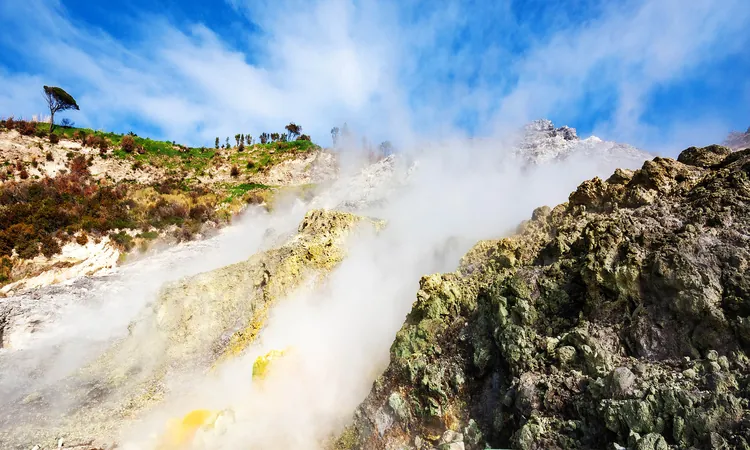
Is the Supervolcano Under Naples About to Erupt? Scientists Sound the Alarm!
2024-11-29
Author: Chun
The Phlegraean Fields, a colossal supervolcano located just west of Naples, Italy, are showing signs of awakening, sending ripples of concern throughout the scientific community. This region, known for being one of the top eight global emitters of volcanic carbon dioxide, is critical for monitoring volcanic activity.
The Alarming Signs from Solfatara Crater
Since 2005, the Solfatara crater within the Phlegraean Fields has experienced a significant increase in gas emissions, capturing the attention of researchers and alarmed residents. Volcanologist Gianmarco Buono from the Italian National Institute of Geophysics and Volcanology (INGV) is at the forefront of a study aimed at uncovering the reasons behind this surge in emissions. “Understanding the source of carbon dioxide is vital for reconstructing the magmatic and hydrothermal systems here,” Buono states.
Exciting advancements in research aim to differentiate between carbon dioxide resulting from magma and that released through other geological processes—insights that could benefit volcanic regions globally.
What Makes a Supervolcano So Dangerous?
Supervolcanoes are immense volcanic systems capable of producing eruptions that dwarf those of regular volcanoes—eruptions can release over 1,000 cubic kilometers of materials into the atmosphere, potentially resulting in catastrophic climate changes. Iconic supervolcanoes like Yellowstone have made headlines, but the Phlegraean Fields represent an equally formidable threat.
When supervolcanoes erupt, they often create massive calderas, vast craters encompassing miles of land. Though such eruptions are rare, their far-reaching consequences make them a focus of intense scientific scrutiny.
Heart-Stopping Stats from the Solfatara Crater
Currently, the Solfatara crater emits between 4,000 and 5,000 tons of carbon dioxide daily—roughly equivalent to the emissions released from burning about 500,000 gallons of gasoline each day. Research suggests that 20% to 40% of this carbon dioxide originates from calcite dissolution in surrounding rocks, while 60% to 80% is attributed to the activity of underground magma.
Understanding the Gases Beneath Our Feet
The rising magma pushes gases that have been trapped underground to the surface, releasing substances such as water vapor, carbon dioxide, and sulfur dioxide. Scientists carefully monitor these gases along with changes in seismic activity to forecast potential volcanic eruptions. Not all increases in gas emissions lead to eruptions—sometimes they stem from interactions between hot fluids and rocks above.
A Decades-Long Investigation
The INGV has monitored the Solfatara crater since 1983, initially determining that the gases primarily sourced from deep magma. However, a troubling trend arose in 2005, as gas compositions began shifting away from typical magma signatures. Accompanying temperature rises in the hydrothermal system have raised concerns, and by 2012, alert levels for the area escalated from green to yellow, indicating increased activity.
Shifts in Earth’s Movements
The region has not only shown changes in gas emissions but has also registered small earthquakes and notable ground deformation. These signs suggest the presence of hot fluids circulating beneath the surface, capable of increasing carbon dioxide emissions through interactions with surrounding calcite-rich rocks.
Historical evidence shows that the Phlegraean Fields have had a turbulent volcanic past, with activity spanning back 40,000 years and the last eruption occurring in 1538. Since the 1950s, the area has experienced multiple phases of unrest, underlining that Earth’s geological activities are perpetually evolving.
Why This Matters for Our Future
Deciphering the sources of carbon dioxide emissions in volcanic regions is not just an academic exercise—it’s essential for public safety and environmental monitoring. Differentiating between gases from magma and those from other sources allows scientists to forecast volcanic activity more accurately and assess potential hazards.
Buono’s research provides a critical framework that could be applied to other volcanic systems around the world. “Our goal is to develop a tool that can distinguish magmatic and non-magmatic carbon dioxide effectively,” he explains.
The Future of the Phlegraean Fields
In conclusion, understanding what’s occurring beneath the Phlegraean Fields and Solfatara crater is paramount—not only for scientists but for everyone on Earth. The new findings reveal that rising carbon dioxide levels result from both magma and interactions between hot fluids and underground rocks, crucial information that helps gauge volcanic activity and keep populations safe.
As this research continues, keeping a keen eye on gas emissions and unraveling their sources will be vital for predicting future volcanic behavior. The Phlegraean Fields serve as a potent reminder that our planet is in constant motion, and scientists like Buono are dedicated to unveiling the mysteries lurking just beneath our feet.
Stay tuned for more groundbreaking research news as scientists continue to investigate the earth’s fiery core!



 Brasil (PT)
Brasil (PT)
 Canada (EN)
Canada (EN)
 Chile (ES)
Chile (ES)
 España (ES)
España (ES)
 France (FR)
France (FR)
 Hong Kong (EN)
Hong Kong (EN)
 Italia (IT)
Italia (IT)
 日本 (JA)
日本 (JA)
 Magyarország (HU)
Magyarország (HU)
 Norge (NO)
Norge (NO)
 Polska (PL)
Polska (PL)
 Schweiz (DE)
Schweiz (DE)
 Singapore (EN)
Singapore (EN)
 Sverige (SV)
Sverige (SV)
 Suomi (FI)
Suomi (FI)
 Türkiye (TR)
Türkiye (TR)